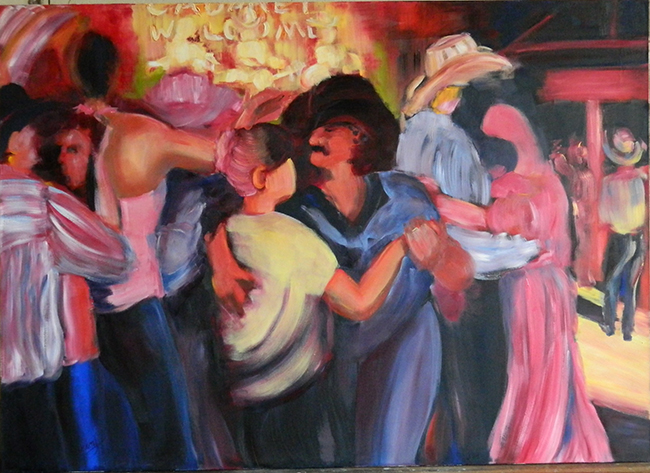Gail Wendorf is an artist whose work bridges her varied passions for art, dance, and culture. Through her paintings, she captures movement, emotion, and the distinct flavor of the environments she immerses herself in. Wendorf’s artistic journey is deeply intertwined with her love for travel, dance, and cultural anthropology, all of which find their way into her vibrant, energetic pieces.

Having spent a lifetime traveling and experiencing different cultures, Wendorf brings a unique perspective to her work. She moves quickly, using sketches, photos, and a limited color palette to capture fleeting moments of light, emotion, and movement. Whether working in a studio or painting en plein air, Wendorf’s method emphasizes the immediacy of the scene. She works with large brushes and palette knives, techniques that allow her to create bold, sweeping strokes that convey the energy and atmosphere of the moment.
Her subjects often range from expansive landscapes to intimate portrayals of people engaged in motion. Wendorf’s background as a dancer also informs her approach to art. She has a natural ability to interpret the rhythm and motion of a scene, translating it onto canvas with remarkable fluidity. Her artistic influences are rooted not only in visual arts but also in dance and music, making her work dynamic and full of life.
One of her most celebrated series, Waltz Across Texas, perfectly embodies this connection between movement and painting. The series is dedicated to capturing the essence of Texas dance halls, places Wendorf has frequented since her teenage years. With a deep appreciation for the traditions of the Two-step, Waltz, and Swing, she delves into the atmosphere of these spaces and the unique communities they foster. These historic dance halls are more than just venues; they are cultural hubs, where people gather, celebrate, and connect through the universal language of dance.
The series features 35 large-scale paintings, each measuring 5 feet by 7 feet, and will be exhibited at the Longview Museum of Art in Texas from May to September 2025. Through this body of work, Wendorf explores the different personalities of each dance hall, highlighting the “flavor” that defines them. Some are carefree and full of joy, while others may have a more subdued, contemplative energy. Yet, no matter the vibe, each hall is a space where tradition and community come alive.
One standout piece from this series is Bandera Cabaret, Cabaret Welcome, a 60 x 84-inch oil painting priced at $14,000. This work showcases a lively Friday night at the Bandera Cabaret in the Hill Country of Texas. Wendorf captures the sense of wild abandon as dancers move across the floor, the energy practically jumping off the canvas. The vibrant colors and loose, expressive brushstrokes convey the excitement and tension of the evening, with one man leaning dramatically over his partner in a bid to hold her closer. The scene is electric, full of life, and perfectly embodies the carefree nature of the night.
What sets Wendorf apart is her ability to infuse her paintings with a deep emotional connection to her subjects. She doesn’t just paint what she sees; she paints what she feels. This is evident in how she describes the dancers’ expressions of joy or concentration, which she translates into vivid bursts of color. The large scale of her canvases allows viewers to be fully immersed in the scene, feeling as if they are part of the dance themselves. It’s this emotional punch that draws people to her work.
Throughout her career, Wendorf has consistently explored the interplay between culture and movement. Before returning to her artistic roots, she produced shows on tribal dance around the world, an experience that broadened her understanding of how different societies express themselves through movement. This global perspective is still evident in her work, where dance becomes a universal language that transcends borders.
For Wendorf, painting isn’t just about creating beautiful images; it’s about capturing the spirit of a place, a moment, or a group of people. Her work reflects a deep appreciation for the cultural richness of the places she paints, from the dance halls of Texas to the tribal communities she’s studied.
Ultimately, Wendorf’s work is a celebration of life, movement, and the connections that bring people together. Her paintings are alive with color, energy, and emotion, inviting the viewer to step inside and experience the dance for themselves.

